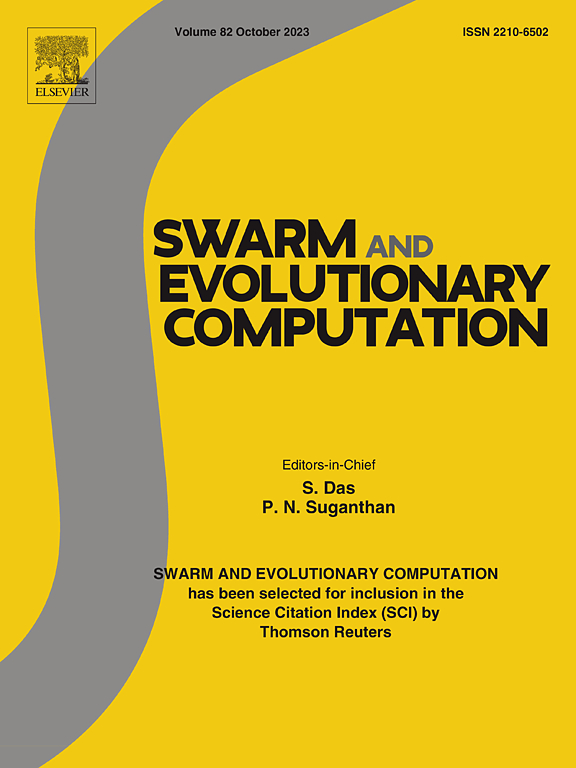Heterogeneous approximation-assisted search for expensive multi-objective optimization
IF 8.2
1区 计算机科学
Q1 COMPUTER SCIENCE, ARTIFICIAL INTELLIGENCE
引用次数: 0
Abstract
The cheap surrogate model is commonly used to guide the multi-objective optimization algorithm in the search for the optimum of the expensive optimization problem. However, modeling diversity and its quality are the keys that affect the performance of approximating the original problem. Using multiple heterogeneous models can provide more diverse approximations for complicated optimization problems. Meanwhile, the location relationship between individuals and training samples is a potential benefit for selecting infill individuals to update the model. Therefore, this paper proposes to train two heterogeneous models for each expensive objection function, with the update of the models using the promising individuals based on the approximated domination relationship and the crowding distance between individuals and evaluated samples. Differently, the function estimation of each individual is the sum of two predicted values in a probability-weighted way together with its uncertainty. In addition, the promising individuals are selected by the dominant numbers or the distance to the decision domain center and the crowding distance to the neighbors, otherwise adopting the difference in convergence and crowding distance between all candidates and the training samples to select the individual for expensive function evaluations if the training set dominates all offspring individuals. Experimental studies analyze the effectiveness of the heterogeneous approximation-based guiding search and examine the superiority of the proposed algorithm compared to five recent epidemic optimization algorithms for DTLZ, WFG benchmark problems, and a practical application.
昂贵多目标优化的异构逼近辅助搜索
廉价代理模型通常用于指导多目标优化算法寻找昂贵优化问题的最优解。然而,模型的多样性及其质量是影响逼近原问题性能的关键。使用多个异构模型可以为复杂的优化问题提供更多样化的近似。同时,个体与训练样本之间的位置关系是选择填充个体更新模型的潜在优势。因此,本文提出为每个昂贵的目标函数训练两个异构模型,并根据近似的支配关系和个体与评估样本之间的拥挤距离,使用有希望的个体对模型进行更新。不同的是,每个个体的函数估计是以概率加权的方式将两个预测值与其不确定性相加。此外,通过优势数或到决策域中心的距离和到邻居的拥挤距离来选择有希望的个体,否则,如果训练集优于所有子代个体,则采用所有候选样本与训练样本之间的收敛性和拥挤距离的差值来选择个体进行昂贵的函数评估。实验研究分析了基于异构近似的引导搜索的有效性,并在DTLZ、WFG基准问题和实际应用中,对比了所提算法与最近五种流行病优化算法的优越性。
本文章由计算机程序翻译,如有差异,请以英文原文为准。
求助全文
约1分钟内获得全文
求助全文
来源期刊

Swarm and Evolutionary Computation
COMPUTER SCIENCE, ARTIFICIAL INTELLIGENCEC-COMPUTER SCIENCE, THEORY & METHODS
CiteScore
16.00
自引率
12.00%
发文量
169
期刊介绍:
Swarm and Evolutionary Computation is a pioneering peer-reviewed journal focused on the latest research and advancements in nature-inspired intelligent computation using swarm and evolutionary algorithms. It covers theoretical, experimental, and practical aspects of these paradigms and their hybrids, promoting interdisciplinary research. The journal prioritizes the publication of high-quality, original articles that push the boundaries of evolutionary computation and swarm intelligence. Additionally, it welcomes survey papers on current topics and novel applications. Topics of interest include but are not limited to: Genetic Algorithms, and Genetic Programming, Evolution Strategies, and Evolutionary Programming, Differential Evolution, Artificial Immune Systems, Particle Swarms, Ant Colony, Bacterial Foraging, Artificial Bees, Fireflies Algorithm, Harmony Search, Artificial Life, Digital Organisms, Estimation of Distribution Algorithms, Stochastic Diffusion Search, Quantum Computing, Nano Computing, Membrane Computing, Human-centric Computing, Hybridization of Algorithms, Memetic Computing, Autonomic Computing, Self-organizing systems, Combinatorial, Discrete, Binary, Constrained, Multi-objective, Multi-modal, Dynamic, and Large-scale Optimization.
 求助内容:
求助内容: 应助结果提醒方式:
应助结果提醒方式:


